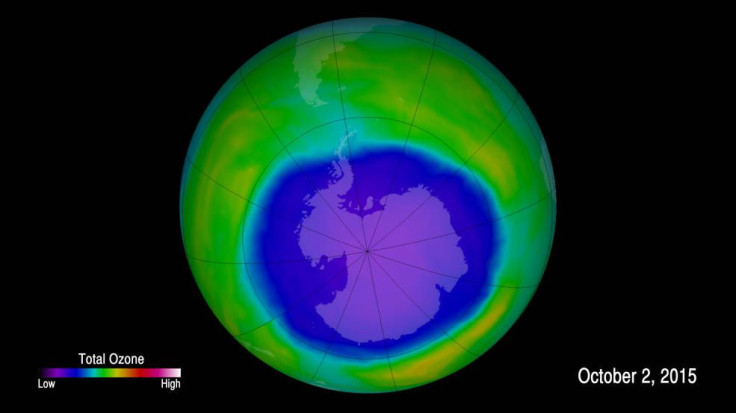Ozone Hole Over Antarctica Expands, Reaches Near-Record Size

The hole in the ozone layer over Antarctica has expanded to near-record levels, scientists from NASA and the National Oceanic and Atmospheric Administration (NOAA) said Thursday. Compared to the 1991-2014 period, the ozone hole's average area this year was the fourth largest.
Observations show that the hole -- formed as a result of depletion of the crucial, radiation-shielding ozone layer -- was spread across an area of 10.9 million square miles -- covering a region larger than the continent of North America -- on Oct. 2. In comparison, the hole peaked at 9.3 million square miles last year.
“While the current ozone hole is larger than in recent years, the area occupied by this year’s hole is consistent with our understanding of ozone depletion chemistry and consistent with colder than average weather conditions in Earth’s stratosphere, which help drive ozone depletion,” Paul A. Newman, chief scientist for earth sciences at NASA’s Goddard Space Flight Center in Greenbelt, Maryland, said, in a statement.
Ozone -- a highly-reactive molecule containing three oxygen atoms -- is constantly being formed and broken down in the atmosphere, in a region 9 to 18 miles from the surface of the planet. The ozone layer helps shield life on the planet from potentially harmful ultraviolet radiation that can cause skin cancer, cataracts, and suppress immune systems, as well as damage plant life.
However, in the 1980s, scientists found that the ozone layer above the South Pole was showing signs of severe depletion, primarily because of the presence of high levels of chemically active forms of chlorine and bromine released by man-made compounds like chlorofluorocarbons -- once widely used in refrigerators and air conditioners.
Since then, scientists have observed seasonal fluctuations in the size of the ozone hole. It normally reaches its widest extent in the southern hemisphere in the spring (August and September), as extreme cold temperatures in the stratosphere facilitate chemical reactions on the surface of polar stratospheric clouds. The expansion of the ozone hole this year is believed to have been caused by unseasonably cold temperatures, rather than any additional damage to the ozone layer.
“This year, our balloon-borne instruments measured nearly 100 percent ozone depletion in the layer above South Pole Station, Antarctica, that was 14 to 19 kilometers (9 to 12 miles) above Earth’s surface,” Bryan Johnson, a researcher at NOAA’s Earth System Research Laboratory in Boulder, Colorado, said, in the statement. “During September we typically see a rapid ozone decline, ending with about 95 percent depletion in that layer by October 1. This year the depletion held on an extra two weeks resulting in nearly 100 percent depletion by October 15.”
While the large size of this year’s ozone hole is likely to result in an increase in the amount of harmful ultraviolet rays striking the Earth’s surface -- particularly in Antarctica and the Southern Hemisphere -- in the coming months, it does not reverse estimates of the projected long-term recovery in the coming decades, the World Meteorological Organization said, in a statement. Current estimates project a substantial recovery of the ozone layer over the Antarctic by around 2070.
© Copyright IBTimes 2024. All rights reserved.






















